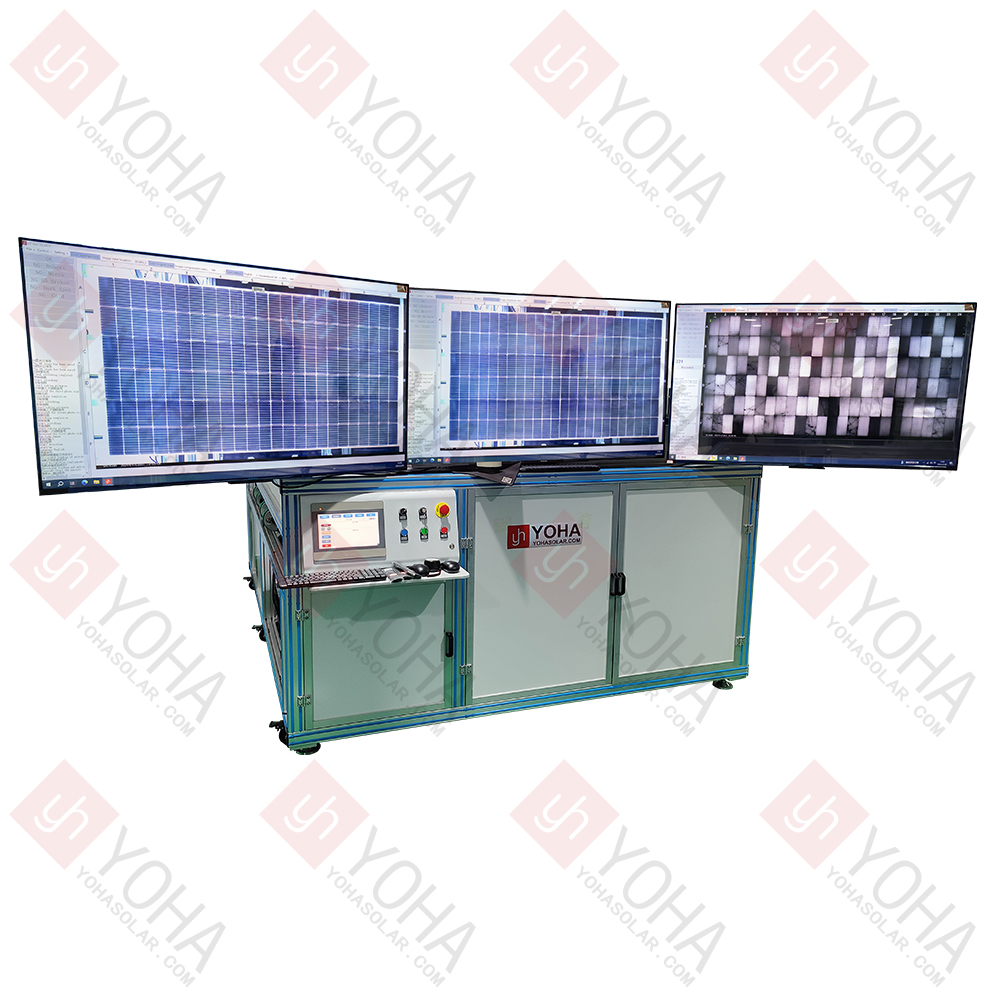Welcome to Wuhan Yoha Solar Technology Co., Ltd!
common problem
Site Map
Language:
 Chinese
Chinese
 English
English
Welcome to Wuhan Yoha Solar Technology Co., Ltd!
common problem
Site Map
Language:
 Chinese
Chinese
 English
English
The Online Double-Glass Module EL Appearance Defect Detector is a high-precision automated device integrated into production lines. It utilizes Electroluminescence (EL) imaging technology to rapidly identify internal cell defects in double-glass photovoltaic modules, such as micro-cracks, broken fingers, and cell fragments. Simultaneously, it employs a high-resolution vision system to accurately detect various surface flaws like scratches, dirt, chipped edges, bubbles, delamination, foreign objects, missing corners, and poor glass appearance. It achieves synchronous, efficient, and comprehensive detection of both EL and appearance defects, ensuring strict quality control for outgoing double-glass modules.

Dual-Mode Synchronous Detection Technology: Integrates Electroluminescence (EL) detection and high-resolution optical appearance inspection. Performs a comprehensive, synchronous scan of both internal cell defects (micro-cracks, broken fingers, fragments, etc.) and surface appearance flaws (scratches, dirt, chipped edges, bubbles, delamination, foreign objects, missing corners, poor glass) in one pass, eliminating blind spots.
Fully Automated Online Process: Seamlessly integrated into the production line. Enables fully automatic positioning, image acquisition, analysis, and judgment of modules during production flow. Eliminates manual intervention or offline handling, significantly improving detection efficiency (up to millisecond-level per cell) and maintaining production rhythm.
High-Precision Intelligent Recognition: Employs advanced AI vision algorithms and deep learning models for millimeter-level precise analysis and classification of EL and appearance images. Effectively distinguishes complex background interference, significantly reducing false positive and false negative rates, ensuring high accuracy and reliability in defect identification.
Intelligent Data Integration & Management: Generates real-time detailed inspection reports including defect type, location, size, and images. Seamlessly interfaces with MES/factory management systems. Provides data traceability, process monitoring, and quality analysis functions, offering robust data support for process improvement and quality management.
| Item | Parameter |
|---|---|
| Model Specification | YH-EL12 |
| Applicable Process Stage | Defect Detection Pre/Post Lamination |
| Testing Specification | Double-Glass Monocrystalline, Polycrystalline Cell Modules |
| Camera Type | Professional Industrial Cameras |
| Resolution | EL: 60 Megapixels, Dual Appearance: 24 Megapixels |
| Imaging Mode | 12-Camera Mode |
| Sensitivity | Detects cracks narrower than 0.03mm |
| Loading Method | Automatic Loading/Unloading |
| Detection Method | Online Automatic Detection |
| Effective Test Area | 2600×1500mm |
| Stabilized Power Supply | 60V/20A |
| Image Acquisition Time | 100~700ms |
| Power Supply | 220V/50 Hz |
| Equipment Dimensions | 3095×2220×1665mm |
1. Online Production Line Quality Inspection: Integrated at the end of the PV module automated production line. Performs high-speed, fully automatic EL and appearance defect detection on newly encapsulated modules. A core step to ensure outgoing product quality and control production yield.
2. Laboratory Fine Analysis: Applied in laboratories of manufacturing enterprises or third-party testing institutions. Enables deeper, more precise defect diagnosis, process effect evaluation, and failure analysis on raw materials (e.g., cells), process samples, and finished modules.
3. Power Plant O&M and Diagnosis: Used (often via portable or mobile EL devices) during PV power plant construction (checking installation damage) and operation (locating faulty modules like hot spots, micro-cracks, PID). Facilitates on-site quality checks, performance evaluation, and fault troubleshooting.
4. R&D and Certification Testing: Serves module R&D institutions and certification testing centers. Provides critical defect detection and quality assessment data during new product development, new material/process validation, long-term reliability studies (e.g., pre/post aging test comparison), and compliance with IEC/UL standard certification requirements.
1. Electrical Current Safety Warning: The device applies DC current to the module during operation. Operators must strictly follow safety procedures, wear insulated equipment, ensure proper grounding, and strictly prohibit touching electrodes or live parts of the module while powered on to prevent electric shock.
2. Darkroom Environment Requirement: EL detection must be performed in a completely light-tight darkroom or enclosed chamber. Any external light source (including indicator lights, phone screens) can interfere with EL images, causing false positives or false negatives. Always confirm environmental light sealing before testing.
3. Module Handling & Placement Specifications: Large modules (especially double-glass) are heavy and fragile. Handle and place them onto the detection platform gently and precisely to avoid collisions, drops, or damage to the module, platform, or probes.
4. Optical System Maintenance: High-sensitivity camera lenses, light sources, and reflectors require regular cleaning and maintenance (using specialized tools and cleaning agents) to prevent dust, stains, or fingerprints from affecting image clarity and detection accuracy. Avoid direct strong light exposure to lenses.
5. Software Calibration & Parameter Settings: Set appropriate current/voltage parameters, exposure time, and image processing algorithm thresholds corresponding to different module models and power ratings. Perform regular software calibration (e.g., dark field correction, flat field correction) to ensure image quality and the accuracy/consistency of defect determination.
6. Device Compatibility & After-Sales Requirements: Confirm device compatibility with the dimensions, electrical parameters, and connector types of the modules to be tested before use. Strictly follow the manufacturer's manual for installation, operation, and maintenance. Contact professional after-sales personnel for critical component repairs or software upgrades to avoid self-disassembly causing malfunctions or warranty invalidation.
TOP
18086473422
MESSAGE
